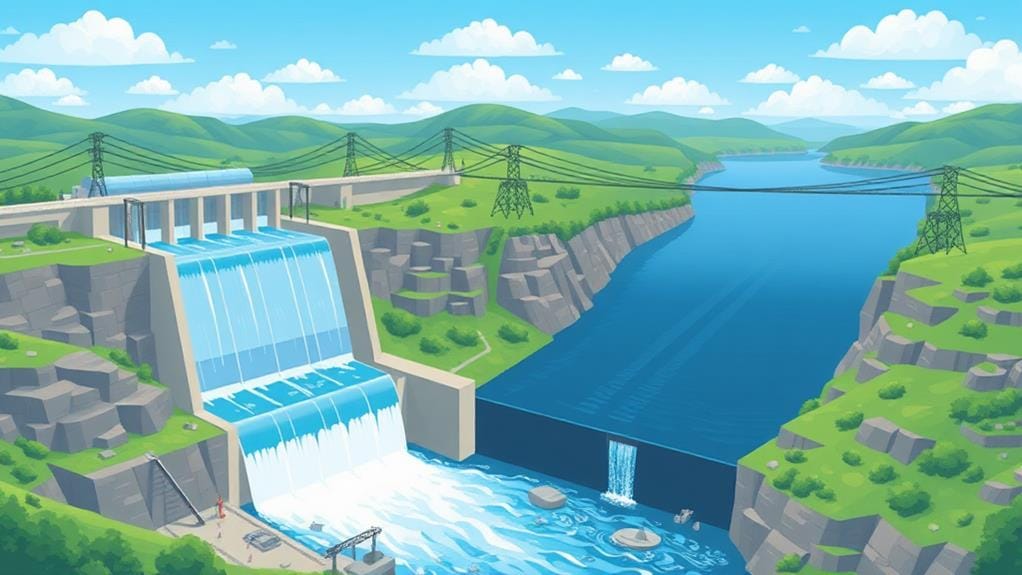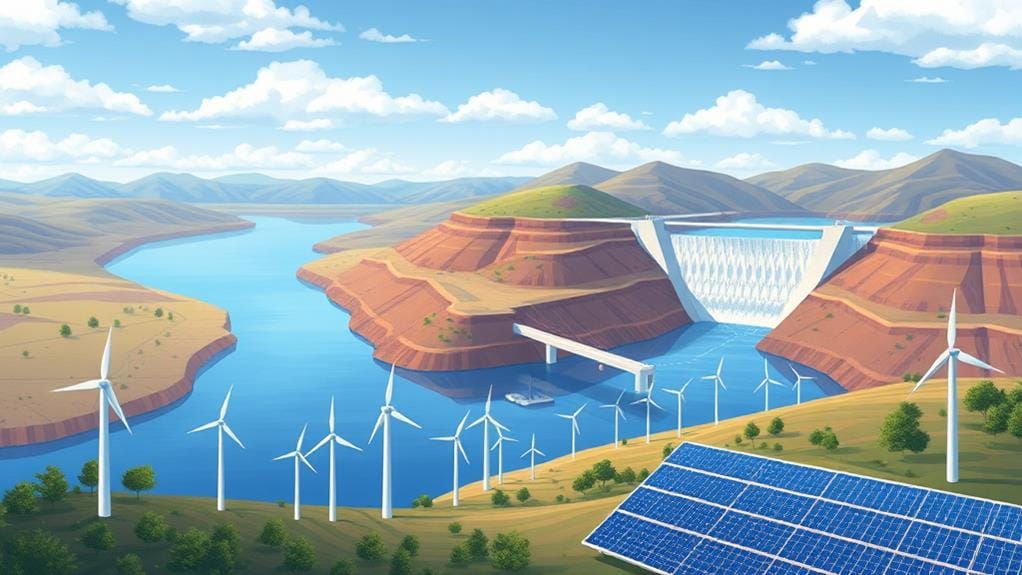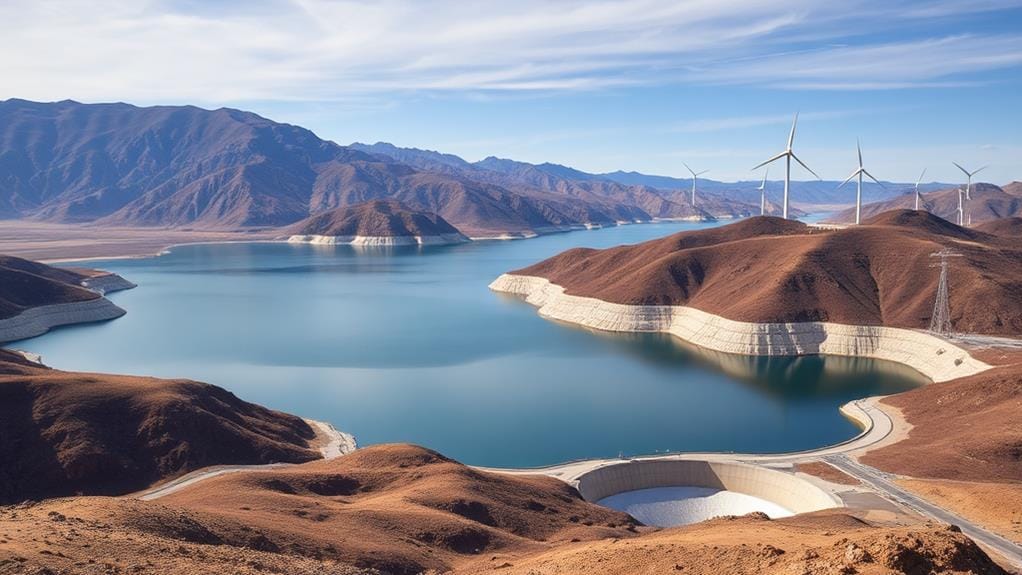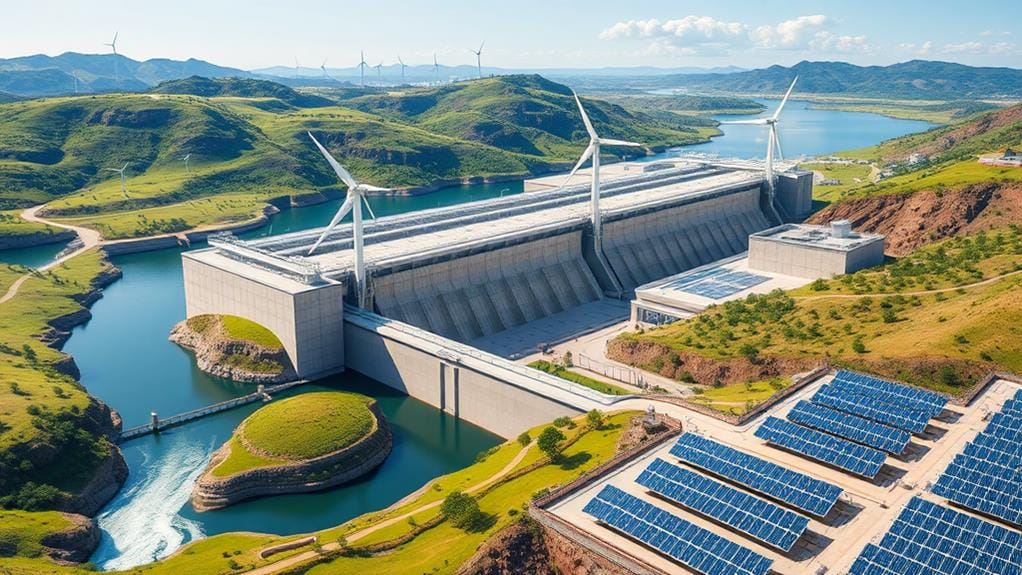Pumped storage hydropower (PSH) is essential for renewable energy integration, providing approximately 22 GW of electricity-generating capacity and 550 GWh of energy storage in the U.S. By utilizing two reservoirs at different elevations, PSH effectively balances supply and demand, discharging electricity for over eight hours during peak times while storing energy when demand is low. This technology facilitates the adoption of variable renewable sources like wind and solar, improves grid stability through services such as frequency control and voltage regulation, and has a lower lifecycle carbon footprint compared to conventional battery systems. Exploring its full potential reveals significant advantages.
Key Takeaways
- Pumped storage hydropower (PSH) provides long-duration energy storage, crucial for balancing intermittent renewable energy sources like solar and wind.
- With a capacity of 550 GWh, PSH can discharge electricity for over eight hours, supporting peak demand and grid stability.
- PSH has a lower lifecycle carbon footprint than lithium-ion batteries, aiding in reducing overall greenhouse gas emissions.
- The technology enhances grid services such as frequency control and voltage regulation, essential for integrating renewable energy into the power system.
- PSH’s expansion potential, with over 600,000 identified sites, allows for greater renewable energy integration and energy security.
Overview of Pumped Storage Hydropower
Pumped storage hydropower (PSH) is an essential component of our energy landscape, accounting for a remarkable 96% of utility-scale energy storage in the U.S. This technology operates by utilizing two water reservoirs at differing elevations: an upper reservoir and a lower reservoir. During periods of low energy demand, we pump water from the lower reservoir to the upper reservoir, effectively storing energy. When demand peaks, we release that water to generate electricity, functioning much like a giant battery. With an electricity-generating capacity of approximately 22 GW and an energy storage capacity of around 550 GWh, PSH plays a vital role in integrating renewable energy sources, enhancing sustainability, and minimizing the carbon footprint associated with energy production.
Benefits of Pumped Storage

As we explore the benefits of pumped storage hydropower, it is crucial to recognize its role in ensuring energy stability, particularly as we integrate more variable renewable energy sources like wind and solar into our grid. This technology not only facilitates emission reductions through its lower carbon footprint compared to traditional storage options, but it also proves to be cost-effective and efficient, offering significant savings over the lifecycle of the system. By providing long-duration energy storage, pumped storage systems enhance the reliability of our energy supply, ultimately supporting a cleaner and more resilient power sector.
Energy Stability Assurance
Harnessing the potential of pumped storage hydropower (PSH) plays an essential role in ensuring energy stability in our increasingly renewable-focused grid. As PSH accounts for over 90% of long-duration energy storage globally, it provides over 550 GWh of energy storage capacity in the U.S. alone, effectively addressing the intermittent nature of wind and solar power. By discharging electricity for over eight hours, we can reliably balance energy supply during peak demand. Additionally, PSH systems deliver critical grid services, including system inertia, frequency control, and voltage regulation, enhancing overall reliability. With a lower lifecycle carbon footprint than lithium-ion batteries, PSH aligns with our emissions reduction goals and supports national climate objectives, making it a cornerstone for our sustainable energy future.
Environmental Emission Reduction
When considering sustainable energy solutions, the benefits of pumped storage hydropower (PSH) in reducing environmental emissions become increasingly clear. PSH systems demonstrate significant sustainability benefits, showing lower lifecycle emissions compared to lithium-ion and vanadium redox flow batteries. Additionally, emissions assessments reveal that the carbon footprint associated with PSH can be minimized through careful planning and construction management. By promoting biodiversity and enhancing water management, closed-loop PSH systems contribute to environmental preservation. Expanding PSH usage not only enhances energy security but also aligns with national climate goals by reducing reliance on carbon-intensive sources.
| Aspect | PSH Benefits | Comparison to Other Solutions |
|---|---|---|
| Greenhouse Gas Emissions | Lower emissions overall | Higher emissions for batteries |
| Carbon Footprint | Reduced through lifecycle | Significant footprint for other tech |
| Biodiversity | Promotes ecosystem health | Limited benefits elsewhere |
Cost-Effectiveness and Efficiency
Pumped storage hydropower (PSH) stands out as one of the most cost-effective solutions for long-duration energy storage, accounting for over 90% of the global market. With an installed capacity nearing 200 GW, and projected to reach approximately 240 GW by 2030, PSH exemplifies significant potential for advancing renewable energy integration. Its low-lifetime costs stem from the ability to deliver energy storage and generation without reliance on raw materials, unlike battery systems. Additionally, PSH facilities provide essential grid services—such as frequency control and voltage regulation—enhancing overall efficiency at a fraction of the cost of alternative technologies. The flexibility of PSH allows for long discharge durations, reducing emissions and alleviating transmission congestion, ultimately benefiting the entire power sector.
Operational Mechanism

At its core, the operational mechanism of pumped storage hydropower (PSH) is quite fascinating. This system utilizes two reservoirs at different elevations to manage energy storage and electricity generation. During low electricity demand, we pump water to the upper reservoir, and during peak demand, we release it to flow through turbines, converting kinetic energy into electrical energy.
- It offers long-duration storage, supporting renewable energy sources.
- The flexibility of PSH systems allows us to adapt to variable energy production.
- The size of the turbines determines our electricity generation capacity.
- Water flow between reservoirs guarantees efficient energy management.
This operational framework is crucial for advancing our energy shift, as it seamlessly integrates renewable energy into our grid.
Types of Pumped Hydro Systems

While exploring the various types of pumped storage hydropower systems, we find that they can be broadly categorized into open-loop and closed-loop systems. Open-loop systems directly utilize water from naturally flowing sources, such as rivers, relying on the water cycle for their operation. In contrast, closed-loop systems are typically constructed off-river, employing internal reservoirs and minimizing environmental impact and water usage. Both systems primarily function for energy storage and generation, but their designs can greatly influence efficiency and overall environmental footprint. The selection between these systems often depends on geographical considerations and hydrological availability. The Water Power Technologies Office actively promotes advancements in both types, enhancing their efficiency and sustainability in the context of renewable energy development.
Market Position and Capacity

As we explore the market position and capacity of pumped storage hydropower (PSH), it’s essential to recognize that PSH currently dominates the global long-duration energy storage landscape, accounting for over 90% of the market with an installed capacity approaching 200 GW. With the International Hydropower Association identifying more than 600,000 potential off-river sites for future development, the expansion opportunities are significant, particularly as we anticipate growth to approximately 240 GW by 2030. However, we must also consider the market challenges and potential solutions that could impact our ability to fully capitalize on these expansion prospects.
Global Energy Storage Leader
Pumped storage hydropower (PSH) stands out as the dominant force in global energy storage, accounting for over 90% of long-duration capacity with nearly 200 GW installed. This remarkable energy storage technology not only supports the integration of renewable resources but also sets the stage for future capacity growth. As we explore the landscape of hydropower projects, we can feel a sense of belonging to a community that’s driving change.
- We’re harnessing nature’s potential.
- Together, we’re paving the way for sustainable energy.
- Our commitment fuels innovation and investment.
- We envision a future where energy storage capacity meets demand.
With an installed capacity of 22 GW in the U.S. alone and over 100 PSH projects underway, the momentum for PSH expansion is undeniable.
Expansion Potential and Opportunities
With nearly 200 GW of installed capacity, pumped storage hydropower (PSH) is uniquely positioned for expansion in the energy storage market. This dominant technology, accounting for over 90% of long-duration energy storage globally, is projected to rise to approximately 240 GW by 2030. We have over 600,000 identified off-river sites that present substantial opportunities for new PSH projects, particularly in regions with favorable geographical conditions. Additionally, the retrofitting of non-powered dams and disused mines is gaining traction, enhancing our capacity to leverage existing infrastructure. Currently, over 100 PSH projects are in the pipeline, reflecting renewed interest and investment in this vital technology, which plays an integral role in supporting renewable energy integration and ensuring grid reliability.
Market Challenges and Solutions
One of the significant hurdles we face in expanding pumped storage hydropower (PSH) capacity is the existing market regulations that often lack incentives for new project development. Without these incentives, we struggle to access the full potential of PSH, which currently represents over 90% of long-duration energy storage globally.
To address these challenges, we must focus on fostering:
- Clear project certainty to attract investment
- Streamlined regulatory processes that support PSH expansion
- Collaboration among stakeholders to enhance market conditions
- Increased awareness of PSH’s role in renewable energy integration
As highlighted by the International Hydropower Association, with over 600,000 identified off-river sites in the U.S., the opportunity for PSH growth is significant; we just need the right regulatory framework to realize it.
Environmental Impact

There’s a growing recognition of the environmental advantages offered by pumped storage hydropower (PSH) as we seek sustainable energy solutions. PSH demonstrates lower greenhouse gas emissions compared to utility-scale batteries, greatly reducing our carbon footprint in energy storage. Its lifecycle emissions, assessed from construction to decommissioning, reflect its overall sustainability, particularly when considering materials like concrete and steel. The closed-loop system not only enhances water management practices but also promotes biodiversity by minimizing environmental disruption, thanks to careful project planning. By supporting national climate goals, PSH is central to our energy shift, mitigating the environmental impacts typically associated with other renewable energy technologies. Consequently, it emerges as a crucial component of a clean energy future, ensuring both sustainability and resilience.
Challenges and Solutions

Facing numerous challenges, the expansion of pumped storage hydropower (PSH) is hindered by inadequate market regulations that fail to incentivize new developments. This lack of support limits investment in this significant technology, which is imperative for integrating renewable energy.
- Insufficient valuation of flexibility and storage services
- Complex permitting processes that slow down projects
- Uncertain financial viability hindering investor confidence
- Inadequate policy frameworks creating barriers for new projects
Despite these obstacles, over 100 PSH projects are currently in the development pipeline, signaling a renewed interest in long-duration energy storage solutions. The International Hydropower Association is working to enhance project certainty, streamline permitting, and improve guidance notes to de-risk investments in pumped storage hydropower. Together, we can create a more supportive environment for this essential sector.
Future Prospects and Innovations

As we look towards the future, the prospects for pumped storage hydropower (PSH) appear promising, driven by innovative technologies and an increasing commitment to renewable energy integration. With the global installed capacity nearing 200 GW and projected to reach 240 GW by 2030, we’re witnessing a strong interest in this crucial sector. Advanced turbine and pump designs are enhancing efficiency and performance, thereby reducing costs and environmental impacts. Additionally, ongoing research, supported by the Water Power Technologies Office, prioritizes environmental sustainability and grid resilience. Investment in retrofitting existing infrastructure fosters capacity expansion, while stakeholder collaboration and policy development are essential for traversing challenges. Together, we can guarantee the robust growth and innovation of PSH in our renewable energy landscape.
Frequently Asked Questions
Why Is Pumped Storage Hydroelectric Becoming Such an Important Energy Source?
Pumped storage is becoming essential for our energy future. It enhances grid stability, supports renewable integration, and offers efficiency gains. Together, we can explore investment opportunities, embrace technology advancements, and promote climate resilience with minimal environmental impact.
Why Is Energy Storage Important for Renewables?
We can’t overstate how essential energy storage is for renewables; it guarantees grid stability and reliable energy even with intermittent supply. Together, we can embrace technological advancements and policy support for cost-efficient, impactful solutions that enhance demand response.
What Is the Main Advantage of Pumped Storage Hydropower Plants?
When we think about the main advantage of pumped storage hydropower plants, we see efficiency gains in renewable integration, ensuring grid stability and energy reliability, while offering cost-effectiveness and minimal environmental impact through effective water management and seasonal storage.
Why Is Hydropower the Best Renewable Energy Source?
Imagine rivers dancing with energy. Hydropower’s efficiency and minimal environmental impact not only promise energy security but also enhance renewable integration. With technological advancements, we can harness hydrological cycles for economic benefits, climate resilience, and sustainable land use together.




